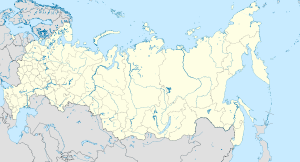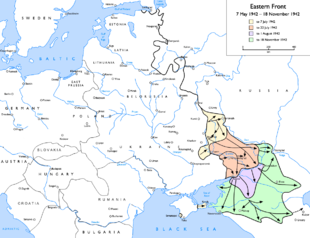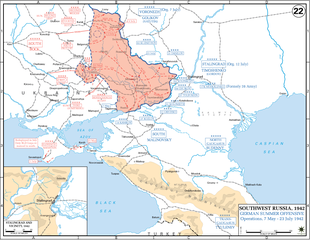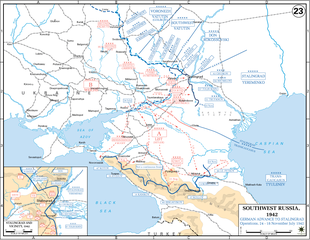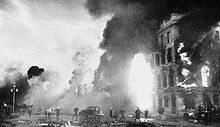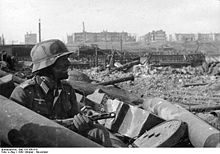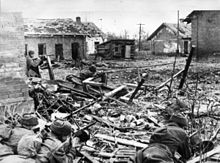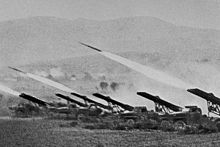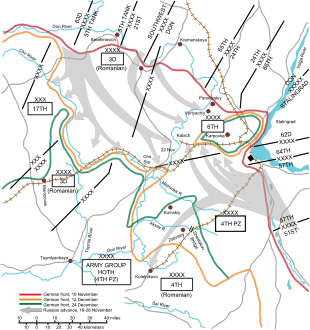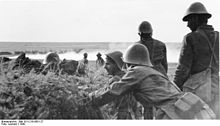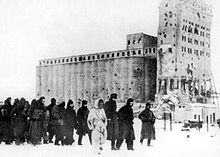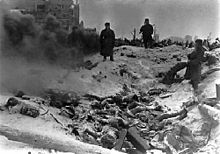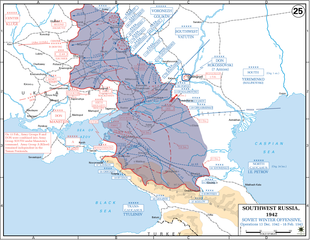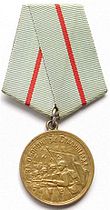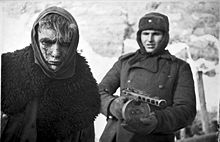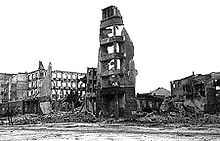- Battle of Stalingrad
-
Coordinates: 48°42′N 44°31′E / 48.7°N 44.517°E
Battle of Stalingrad Part of the Eastern Front of World War II 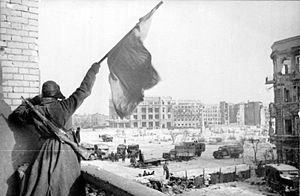
Soviet soldier waving the Red Banner over the central plaza of Stalingrad in 1943.Date 23 August 1942 – 2 February 1943 Location Stalingrad, Russian SFSR, Soviet Union Result Decisive Soviet victory Belligerents  Germany
Germany
 Soviet Union
Soviet UnionCommanders and leaders  Adolf Hitler
Adolf Hitler
 Erich von Manstein
Erich von Manstein
 Friedrich Paulus
Friedrich Paulus 
 Hermann Hoth
Hermann Hoth
 Wolfram von Richthofen
Wolfram von Richthofen
 Petre Dumitrescu
Petre Dumitrescu
 C. Constantinescu
C. Constantinescu
 Italo Gariboldi
Italo Gariboldi
 Gusztáv Vitéz Jány
Gusztáv Vitéz Jány
 Agustín Muñoz Grandes
Agustín Muñoz Grandes
 Viktor Pavičić †
Viktor Pavičić † Joseph Stalin
Joseph Stalin
 Georgy Zhukov
Georgy Zhukov
 Nikolay Voronov
Nikolay Voronov
 A.M. Vasilevsky
A.M. Vasilevsky
 Andrei Yeremenko
Andrei Yeremenko
 Nikita Khrushchev
Nikita Khrushchev
 K.K. Rokossovsky
K.K. Rokossovsky
 Nikolai Vatutin
Nikolai Vatutin
 Vasily Chuikov
Vasily ChuikovUnits involved Army Group B: - German 6th Army
- German 4th Panzer Army
- Romanian 3rd Army
- Romanian 4th Army
- Italian 8th Army
- Hungarian 2nd Army
- Spanish volunteer "Blue Division"
- Croatian Legion
Stalingrad Front Strength Initial:
270,000 men
3,000 artillery pieces
500 tanks
600 aircraft, 1,600 by mid-September (Luftflotte 4)[Note 3][1]
At the time of the Soviet counter-offensive:
700,000 men (400,000 Germans, 200,000 Romanians, 100,000 Italians) [2][3]
10,250 artillery pieces
500 tanks [2][3]
732 (402 operational) aircraft[4]:225[5]:87Initial:
187,000 men
2,200 artillery pieces
400 tanks
300 aircraft[1]:72
At the time of the Soviet counter-offensive: 1,143,500 men
13,451 artillery pieces
894 tanks[6]
1,115[4]:224 aircraftCasualties and losses est. 750,000 killed, missing or wounded
91,000 captured
900 aircraft (including 274 transports and 165 bombers used as transports)
1,500 tanks
6,000 artillery pieces[1]:122–123
Total: 841,000 casualties478,741 killed or missing
650,878 wounded and sick
40,000 civilians dead
4,341 tanks
15,728 artillery pieces
2,769 combat aircraft [7]
Total: 1,129,619 casualties1 Over 11,000 Axis soldiers continued to fight until early March, 1943. Naval warfare
Baltic Sea - Black Sea - Arctic - (Arctic Convoys - Rösselsprung - Wunderland)
1941
Barbarossa - (Białystok and Minsk - Smolensk - Uman - Leningrad - 1st Kiev - Sevastopol - Rostov - Moscow) - Finland - Chechnya
1942
Battles of Rzhev - (Toropets and Kholm - Demyansk - Velikiye Luki - Mars) - 2nd Kharkov - Case Blue - Stalingrad - (Uranus - Winter Storm)
1943
3rd Kharkov - Kursk - 2nd Smolensk - Lower Dnieper - 2nd Kiev
1944
Dnieper and Carpathian - Leningrad and Novgorod - Narva - Hube's Pocket - Crimea - Jassy-Kishinev - Karelia - Bagration - Lvov and Sandomierz - 2nd Jassy-Kishinev - Baltics - Debrecen - Petsamo and Kirkenes - Hungary
1945
Vistula and Oder - East Prussia - East Pomerania - Solstice - Silesia - Vienna - Berlin - Czechoslovakia - German capitulationBlue – Voronezh – Drive to Caucasus – Caucasus – Drive towards Stalingrad – Stalingrad – 3rd KharkovThe Battle of Stalingrad was a major battle of World War II in which Nazi Germany and its allies fought the Soviet Union for control of the city of Stalingrad (now Volgograd) in southwestern Russia. The battle took place between 23 August 1942 and 2 February 1943.[8]:507[9][10][11] It was among the largest on the Eastern Front and was marked by its brutality and disregard for military and civilian casualties. It was amongst the bloodiest battles in the history of warfare with the higher estimates of combined casualties amounting to nearly two million. In its defeat, the crippling losses suffered by Germany's military proved to be insurmountable for the war. The battle was a turning point in the war,[12] after which the German forces attained no further strategic victories in the East.[13]:553
The German offensive to capture Stalingrad commenced in late summer 1942, supported by intensive Luftwaffe bombing which reduced much of the city to rubble. The German offensive eventually became bogged down in house-to-house fighting; and despite controlling over 90% of the city at times, the Wehrmacht was unable to dislodge the last Soviet defenders clinging tenaciously to the west bank of the Volga River.
In November 1942, the Red Army launched Operation Uranus; a two-pronged attack, targeted at the inferior Romanian and Italian forces which were protecting the German 6th Army flanks. The success of these attacks caused the weakly held flanks to collapse and the 6th Army to be cut off and surrounded inside Stalingrad. As the Russian winter set in, the 6th Army weakened rapidly from cold, starvation and ongoing Soviet attacks. Command ambiguity coupled with Adolf Hitler's resolute belief in the "power of the will" and the value of "standing fast" further compounded the German predicament. Eventually, the failure to break the encirclement by relieving German forces, coupled with the failure of re-supply by air, caused the final collapse. By early February 1943, German resistance in Stalingrad had ceased and the remaining elements of the surrounded 6th Army had either surrendered or had been destroyed.[14]:932
Contents
Background
By the spring of 1942, despite the failure of Operation Barbarossa to decisively defeat the Soviet Union in a single campaign, the war had been progressing well for the Germans: the U-Boat offensive in the Atlantic had been very successful and Rommel had just captured Tobruk.[15]:522 In the east, they had stabilized their front in a line running from Leningrad in the north to Rostov in the south and while there were a number of salients in the line where Soviet offensives had pushed the Germans back (notably to the northwest of Moscow and south of Kharkov), these were not particularly threatening. Hitler was confident that he could master the Red Army after the winter of 1941, based on the fact that although Army Group Centre (Heeresgruppe Mitte) had suffered heavy punishment west of Moscow the previous winter, 65% of its infantry had not been engaged and had been rested and re-equipped. Army Groups North and South had also not been particularly hard pressed over the winter.[16]:144 Stalin in turn, had just issued his "not a step back" order[Note 4] after the Red Army had suffered losses of 259% of their initial strength in 1941[13]:476-477 and was expecting the main thrust of the German summer attacks to again be directed against Moscow.[13]:498
The German summer offensive in the south of the Eastern Front was driven by two main objectives — time and material resources. Hitler was adamant to complete the offensive before the might of the United States joining the war came into play and secondly, he was determined to secure the oil resources in the Caucasus, which would deny them to the Soviet Union while securing an alternative petroleum resource for Germany.[15]:528
The Soviets realized that they were under tremendous constraints of time and resources and ordered that anyone strong enough to hold a rifle be sent to defend the city.[17]:94 At this stage of the war, the Red Army was less capable of highly mobile operations than the German Army. However, combat in large urban areas tends to be dominated by small arms weaponry rather than armoured and mechanized units, much to the detriment of the German forces who were principally trained and experienced in fast-moving panzer led operations.
Prelude
Case Blue
Main article: Case Blue“ If I do not get the oil of Maikop and Grozny then I must finish [liquidieren] this war. Adolf Hitler[18]:514 ” Army Group South was selected for a sprint forward through the southern Russian steppes into the Caucasus to capture the vital Soviet oil fields there. The planned summer offensive was code-named Fall Blau ("Case Blue"). It was to include the German 6th, 17th, 4th Panzer and 1st Panzer Armies. Army Group South had overrun the Ukrainian SSR in 1941. Poised in Eastern Ukraine, it was to spearhead the offensive.
Hitler intervened, however, ordering the Army Group to be split in two. Army Group South (A), under the command of Wilhelm List, was to continue advancing south towards the Caucasus as planned with the 17th Army and First Panzer Army. Army Group South (B), including Friedrich Paulus’ 6th Army and Hermann Hoth's 4th Panzer Army, was to move east towards the Volga and Stalingrad. Army Group B was commanded initially by Field Marshal Fedor von Bock and later by General Maximilian von Weichs.[14]:915
The start of Case Blau had been planned for late May 1942. However, a number of German and Romanian units that were involved in Blau were then in the process of besieging Sevastopol on the Crimean Peninsula. Delays in ending the siege pushed back the start date for Blau several times, and the city did not fall until the end of June. A smaller action was taken in the meantime, pinching off a Soviet salient in the Second Battle of Kharkov, which resulted in the pocketing of a large Soviet force on 22 May.
The German advance to the Don River between 7 May and 23 July.
Blau finally opened as Army Group South began its attack into southern Russia on 28 June 1942. The German offensive started well. Soviet forces offered little resistance in the vast empty steppes and started streaming eastward. Several attempts to re-establish a defensive line failed when German units outflanked them. Two major pockets were formed and destroyed: the first, northeast of Kharkov, on 2 July, and a second, around Millerovo, Rostov Oblast, a week later. Meanwhile, the Hungarian 2nd Army and the German 4th Panzer Army had launched an assault on Voronezh, capturing the city on 5 July.
The initial advance of the 6th Army was so successful that Hitler intervened and ordered the 4th Panzer Army to join Army Group South (A) to the south. A massive traffic jam resulted when the 4th Panzer and the 6th both required the few roads in the area. Both armies were stopped dead while they attempted to clear the resulting mess of thousands of vehicles. The delay was long, and it is thought that it cost the advance at least one week. With the advance now slowed, Hitler changed his mind and re-assigned the 4th Panzer Army back to the attack on Stalingrad.
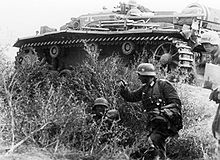 Infantry and a supporting StuG III assault gun advance towards the city center.
Infantry and a supporting StuG III assault gun advance towards the city center.
By the end of July, the Germans had pushed the Soviets across the Don River. At this point, the Don and Volga Rivers were only 40 mi (64 km) apart, and the Germans left their main supply depots west of the Don, which was to have important implications later in the course of the battle. The Germans began using the armies of their Italian, Hungarian, Croatian and Romanian allies to guard their left (northern) flank. The Italians are not often credited with bravery in the fighting, but they won several accolades in official German communiques.[19][20][21][22] They were held in little regard by the Germans, and were often accused of cowardice and low morale: in reality, their ineffectiveness in combat was due to their very scarce equipment, obsolete weaponry, and primitive tactics of Italian officers, thus often being obliged to retreat or flee. They distinguished themselves in numerous battles, as in the battle of Nikolayevka. The German 6th Army was only a few dozen kilometers from Stalingrad, and 4th Panzer Army, now to their south, turned northwards to help take the city. To the south, Army Group A was pushing far into the Caucasus, but their advance slowed as supply lines grew overextended. The two German army groups were not positioned to support one another due to the great distances involved.
After German intentions became clear in July 1942, Stalin appointed Marshal Andrey Yeryomenko as commander of the Southeastern Front on 1 August 1942. Yeryomenko and Commissar Nikita Khrushchev were tasked with planning the defense of Stalingrad.[23]:25, 48 The eastern border of Stalingrad was the wide River Volga, and over the river, additional Soviet units were deployed. These units became the newly formed 62nd Army, which Yeryomenko placed under the command of Lt. Gen. Vasiliy Chuikov on 11 September 1942. The situation was extremely dire. When asked how he interpreted his task, he responded "We will defend the city or die in the attempt."[24]:127 The 62nd Army's mission was to defend Stalingrad at all costs. Chuikov's generalship during the battle earned him one of his two Hero of the Soviet Union awards.
Attack on Stalingrad
The Soviets had enough warning of the Germans' advance to ship virtually all the city's grain, cattle, and railroad rolling stock across the Volga and out of harm's way. This "harvest victory" left the city short of food even before the German attack began. Production continued in some factories, particularly the one producing T-34 tanks. Before the Wehrmacht reached the city itself, the Luftwaffe had rendered the River Volga, vital for bringing supplies into the city, unusable to Soviet shipping. Between 25 and 31 July, 32 Soviet ships were sunk, with another nine crippled.[1]:69
The battle began with the heavy bombing of the city by Generaloberst Wolfram von Richthofen's Luftflotte 4, which in the summer and autumn of 1942 was the most powerful single air formation in the world. Some 1,000 tons of bombs were dropped.[1]:122 The city was quickly turned to rubble, although some factories continued production while workers joined in the fighting. The Croatian 369th Reinforced Infantry Regiment was the only non-German unit[25] selected by the Wehrmacht to enter Stalingrad city during assault operations. It fought as part of the 100th Jäger Division.
Stalin rushed all available troops to the east bank of the Volga, some from as far away as Siberia. All the regular ferries were quickly destroyed by the Luftwaffe, which then targeted troop barges being towed slowly across the river by tugs. Many civilians were evacuated across the Volga.[23] It has been said that Stalin prevented civilians from leaving the city in the belief that their presence would encourage greater resistance from the city's defenders.[24]:106 Civilians, including women and children, were put to work building trenchworks and protective fortifications. A massive German strategic bombing on 23 August caused a firestorm, killing thousands and turning Stalingrad into a vast landscape of rubble and burnt ruins. Ninety percent of the living space in the Voroshilovskiy area was destroyed. Between 23 and 26 August, Soviet reports indicate 955 people were killed and another 1,181 wounded as a result of the bombing.[1]:73 Casualties of 40,000 were exaggerated,[26]:188-189 and after 25 August, the Soviets did not record civilian and military casualties as a result of air raids.[Note 5]
The Soviet Air Force, the Voenno-Vozdushnye Sily (VVS), was swept aside by the Luftwaffe. The VVS assembly in the immediate area lost 201 aircraft between 23 and 31 August, and despite meager reinforcements of some 100 aircraft in August, it was left with just 192 serviceable aircraft, 57 of which were fighters.[1]:74 The Soviets continued to pour aerial reinforcements into the Stalingrad area in late September, but continued to suffer appalling losses; the Luftwaffe had complete control of the skies. However, due to the relocation of Soviet industry in 1941, Soviet aircraft production reached 15,800 in the second half of 1942. The VVS was able to preserve significant strength and build up a strategic reserve that would eventually overpower the Luftwaffe.[1]:86
The burden of the initial defense of the city fell on the 1077th Anti-Aircraft Regiment,[24]:106 a unit made up mainly of young female volunteers who had no training for engaging ground targets. Despite this, and with no support available from other units, the AA gunners stayed at their posts and took on the advancing panzers. The German 16th Panzer Division reportedly had to fight the 1077th’s gunners "shot for shot" until all 37 anti-aircraft batteries were destroyed or overrun. The German 16th Panzer Division was shocked to find that, due to Soviet manpower shortages, it had been fighting female soldiers.[24]:108[27] In the beginning, the Soviets relied extensively on "Workers' militias" composed of workers not directly involved in war production. For a short time, tanks continued to be produced and then manned by volunteer crews of factory workers. They were driven directly from the factory floor to the front line, often without paint or even gunsights.[24]:110
By the end of August, Army Group South (B) had finally reached the Volga, north of Stalingrad. Another advance to the river south of the city followed. By 1 September, the Soviets could only reinforce and supply their forces in Stalingrad by perilous crossings of the Volga under constant bombardment by artillery and aircraft.
On 5 September, the Soviet 24th and 66th Armies organized a massive attack against XIV Panzerkorps. The Luftwaffe helped repulse the offensive by heavily attacking Soviet artillery positions and defensive lines. The Soviets were forced to withdraw at midday after only a few hours. Of the 120 tanks the Soviets had committed, 30 were lost to air attack.[1]:75
Soviet operations were constantly hampered by the Luftwaffe. On 18 September, the Soviet 1st Guards and 24th Army launched an offensive against VIII. Armeekorps at Kotluban. VIII. Fliegerkorps dispatched wave after wave of Stuka dive-bombers to prevent a breakthrough. The offensive was repulsed. The Stukas claimed 41 of the 106 Soviet tanks knocked out that morning, while escorting Bf 109s destroyed 77 Soviet aircraft.[1]:80 Amid the debris of the wrecked city, the Soviet 62nd and 64th Armies, which included the Soviet 13th Guards Rifle Division, anchored their defense lines with strongpoints in houses and factories.
Fighting within the ruined city was fierce and desperate. Lieutenant General Alexander Rodimtsev was in charge of the 13th Guards Rifle Division, and received one of two Heroes of the Soviet Union awarded during the battle for his actions. Stalin's Order No. 227 of 27 July 1942 decreed that all commanders who ordered unauthorized retreat would be subject to a military tribunal. “Not a step back!” and "There is no land behind the Volga!" were the slogans. The Germans pushing forward into Stalingrad suffered heavy casualties.
Hugging tactics
German military doctrine was based on the principle of combined-arms teams and close cooperation between tanks, infantry, engineers, artillery and ground-attack aircraft. To counter this, Soviet commanders adopted the tactic of always keeping the front lines as close to the Germans as physically possible; Chuikov called this "hugging" the Germans. This forced the German infantry to either fight on their own or risk taking casualties from their own supporting fire; it neutralized German close air support and weakened artillery support.[28]
The Soviets understood that, in Stalingrad, the best defense would depend on anchoring their defense lines in numerous buildings overseeing strategically important streets and squares. Such a strategy would hold for as long as possible all the ground the Soviets could take in the city. Thus, they converted multi-floored apartment blocks, factories, warehouses, street corner residences and office buildings into strongholds bristling with machine guns, anti-tank rifles, mortars, mines, barbed wire, snipers and small 5-10 man units of submachine gunners and grenadiers prepared for house-to-house combat.[28]
Bitter fighting raged for every ruin, street, factory, house, basement and staircase. The sewers were the sites of labyrinthine firefights. The Germans, calling this unseen urban warfare Rattenkrieg ("Rat War"), bitterly joked about capturing the kitchen but still fighting for the living room and the bedroom. In such desperate chaos, all battle lines vanished, and the major, armor-supported mobility to which the German soldiers were accustomed degenerated into vicious, fast-paced skirmishes ranging through bombed-out debris of residential neighborhoods, office blocks, basements and apartment high-rises. Some of the taller buildings, blasted into roofless shells by earlier German aerial bombardment, saw floor-by-floor, close-quarters combat, with the Germans and Soviets on alternate levels, firing at each other through holes in the floors.[28]
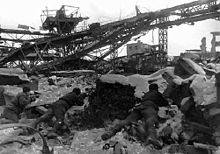 Soviet soldiers in the Red October Factory
Soviet soldiers in the Red October Factory
Fighting on Mamayev Kurgan, a prominent hill above the city, was particularly merciless, and the position changed hands many times.[23]:p? By 12 September, the Soviet 62nd Army had been reduced to 90 tanks, 700 mortars and just 20,000 men.[24]:128
The 13th Guards Rifle Division, assigned to retake Mamayev Kurgan and Railway Station No. 1 on 13 September suffered particularly heavy losses. Over 30 percent of its soldiers were killed in the first 24 hours, and just 320 out of the original 10,000 survived the entire battle. Both objectives were retaken, but only temporarily. The railway station changed hands 14 times in six hours. By the following evening, the 13th Guards Rifle Division had ceased to exist, but its men had killed approximately an equal number of Germans. Combat raged there for weeks near the giant grain silo. When German soldiers finally took the position, only forty dead Soviet fighters were found, though the Germans had thought there were many more due to the ferocious resistance. The Soviets burned heaps of grain during their retreat.
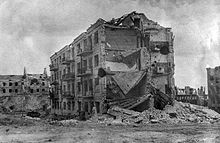 Pavlov's House (1943)
Pavlov's House (1943)
In another part of the city, a Soviet platoon under the command of Yakov Pavlov turned an apartment building that oversaw a square in the city center into an impenetrable fortress, later called "Pavlov's House". The soldiers surrounded it with minefields, set up machine-gun positions at the windows and breached the walls in the basement for better communications.[24]:198 The soldiers found about ten Soviet civilians hiding in the basement. They were not relieved, and not significantly reinforced, for two months. Well after the battle, Chuikov liked to joke that more Germans died trying to capture Pavlov's House than died capturing Paris. According to Beevor, throughout the second month, after each wave of German assault against the building, the Soviets had to run out and kick down the piles of German corpses in order for the machine and anti-tank gunners in the building to have clear firing lines across the square. The building was labeled Festung ("Fortress") on German maps. Sgt. Pavlov was awarded the Hero of the Soviet Union for his actions.
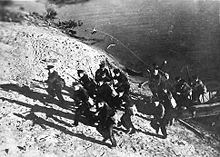 Soviet marines landing on the west bank of the Volga River.
Soviet marines landing on the west bank of the Volga River.
With no end in sight, the Germans started transferring heavy artillery to the city, including the gigantic 800 mm (31.5 in) railroad gun nicknamed "Dora", but made no attempt to send a force across the Volga, allowing the Soviets to build up a large number of artillery batteries on the east side. This artillery continued to bombard the German positions. German tanks became useless amid heaps of rubble up to eight meters high.
Snipers on both sides used the ruins to inflict heavy casualties. The most famous Soviet sniper in Stalingrad was Vasily Zaytsev with 225 confirmed kills during the battle. Zaytsev was one of a whole corps of snipers and had over thirty students, who were credited with killing over three thousand German soldiers during the war.
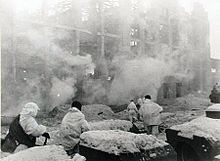 Soviet infantry storming a factory in Stalingrad
Soviet infantry storming a factory in Stalingrad
For both Stalin and Hitler, Stalingrad became a matter of prestige beyond its strategic significance. The Soviet command moved the Red Army's strategic reserves from the Moscow area to the lower Volga, and transferred aircraft from the entire country to the Stalingrad region.
The strain on both military commanders was immense: Paulus developed an uncontrollable tic in his eye, which eventually afflicted the left side of his face, while Chuikov experienced an outbreak of eczema that required him to have his hands completely bandaged. Troops on both sides faced the constant strain of close-range combat.
Air attacks
Determined to crush Soviet resistance, Luftflotte 4's Stukawaffe flew 900 individual sorties against Soviet positions at the Dzerzhinskiy Tractor Factory on 5 October. Several Soviet regiments were wiped out; the entire staff of the Soviet 339th Infantry Regiment were killed the following morning during an air raid.[1]:83
In mid-October, the Luftwaffe intensified its efforts against remaining Red Army positions holding the west bank. Luftflotte 4 flew 2,000 sorties on 14 October and 600 short tons (540 t) of bombs were dropped while German infantry surrounded the three factories. Stukageschwader 1, 2, and 77 had largely silenced Soviet artillery on the eastern bank of the Volga before turning their attention to the shipping that was once again trying to reinforce the narrowing Soviet pockets of resistance. The 62nd Army had been cut in two, and, due to intensive air attack on its supply ferries, was now being paralyzed.
With the Soviets forced into a 1,000 yd (910 m) strip of land on the western bank of the Volga, over 1,208 Stuka missions were flown in an effort to eliminate them.[1]:84 Despite the heavy air bombardment (Stalingrad suffered heavier bombardment than Sedan or Sevastopol), the Soviet 62nd Army, with 47,000 men and 19 tanks, prevented the 6th Army and 4th Panzer Army from taking the Volga's west bank.
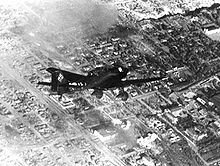 Junkers Ju 87 Stuka dive bomber over Stalingrad.
Junkers Ju 87 Stuka dive bomber over Stalingrad.
The Luftwaffe retained air superiority into early November and Soviet daytime aerial resistance was nonexistent, but after flying 20,000 individual sorties, its original strength of 1,600 serviceable aircraft had fallen to 950. The Kampfwaffe (bomber force) had been hardest hit, having only 232 out of a force of 480 left.[4]:95 Despite enjoying qualitative superiority against the VVS and possessing 80% of the Luftwaffe's resources on the Eastern Front, Luftflotte 4 could not prevent Soviet aerial power from growing. By the time of the counter-offensive, the Soviets outnumbered it.
The Soviet bomber force, the Aviatsiya Dal'nego Deystviya (Long Range Aviation; ADD), having taken crippling losses over the past 18 months, was restricted to flying at night. The Soviets flew 11,317 night sorties over Stalingrad and the Don-bend sector between 17 July and 19 November. These raids caused little damage and were of nuisance value only.[1]:82[29]:265
The situation for the Luftwaffe was now becoming increasingly difficult. On 8 November, substantial units from Luftflotte 4 were withdrawn to combat the Allied landings in North Africa. The German air arm found itself spread thinly across Europe, and struggling to maintain its strength in the other southern sectors of the Soviet-German front.[Note 6] Meanwhile, the Soviet Army was being supplied by the American government under the Lend-Lease program. During the last quarter of 1942, the U.S. sent the Soviet Union 60,000 trucks, 11,000 jeeps, 2 million pairs of boots, 50,000 short tons (45,000 t) of explosives, 450,000 short tons (410,000 t) of steel and 250,000 short tons (230,000 t) of aviation gas.[30]:404 The majority of the American boots, which Stalin requested first[citation needed], reached the troops. However, a part of the military equipment and food supplied by the USA was destroyed by German attacks,[citation needed] as that of Convoy PQ-17.
Germany reaches the Volga
After three months of slow advance, the Germans finally reached the river banks, capturing 90% of the ruined city and splitting the remaining Soviet forces into two narrow pockets. Ice floes on the Volga now prevented boats and tugs from supplying the Soviet defenders. Nevertheless, the fighting, especially on the slopes of Mamayev Kurgan and inside the factory area in the northern part of the city, continued as fiercely as ever. The battles for the Red October Steel Factory, the Dzerzhinsky tractor factory and the Barrikady gun factory became world-famous.
Soviet counter-offensives
Recognizing that German troops were ill prepared for offensive operations during the winter and that most of them were redeployed elsewhere on the southern sector of the Eastern Front, the Stavka decided to conduct a number of offensive operations which took place between 19 November 1942 and 2 February 1943.
These operations opened the Winter Campaign of 1942-1943 (19 November 1942–3 March 1943), which involved some 15 Armies operating on several fronts.
German exhaustion prior to Operation Uranus
The German offensive to take Stalingrad had been halted by a combination of stubborn Red Army resistance inside the city and local weather conditions. The Soviet counter-offensive planning used deceptive measures that eventually trapped and destroyed the 6th Army and other Axis forces around the city, becoming the second large scale defeat of the German Army during World War II.[31]
During the siege, the German and allied Italian, Hungarian, and Romanian armies protecting Army Group B's flanks had pressed their headquarters for support.[32]:209-211 The Hungarian 2nd Army, consisting of mainly ill-equipped and ill-trained units, was given the task of defending a 200 km (120 mi) section of the front north of Stalingrad between the Italian Army and Voronezh. This resulted in a very thin line, with some sectors where 1–2 km (0.62–1.2 mi) stretches were being defended by a single platoon. Soviet forces held several bridgeheads on the western bank of the river and presented a potentially serious threat to Army Group B.[14]:915
Similarly, on the southern flank of the Stalingrad sector the front southwest of Kotelnikovo was held only by the Romanian 7th Army Corps, and beyond it, a single German division, the 16th Motorized Infantry.
However, Hitler was so focused on the city itself that requests from the flanks for support were refused. The Chief of the Army General Staff, Franz Halder, expressed concerns about Hitler's preoccupation with the city, pointing out that if the situation on the weak German flanks was not rectified, "there would be a disaster". Hitler told Halder that Stalingrad would be captured and the weakened flanks would be held with "national socialist ardour, clearly I cannot expect this of you (Halder)", and replaced him with General Kurt Zeitzler in mid-October.[14]:917-918
Operation Uranus: the Soviet offensive
Main article: Operation UranusIn autumn, the Soviet generals Georgy Zhukov and Aleksandr Vasilevsky, responsible for strategic planning in the Stalingrad area, concentrated massive forces in the steppes to the north and south of the city. The German northern flank was particularly vulnerable, since it was defended by Italian, Hungarian, and Romanian units that suffered from inferior equipment, morale, and leadership when compared with their German counterparts. This weakness was known and exploited by the Soviets, who preferred to face off against non-German troops whenever possible, just as the British preferred attacking Italian troops instead of German ones in North Africa. The plan was to keep pinning the Germans down in the city, then punch through the overstretched and weakly defended German flanks and surround the Germans inside Stalingrad. The flanks were to be attacked far enough away from Stalingrad so that the bulk of the 6th Army in Stalingrad could not redeploy to defend against the attack. During the preparations for the attack, Marshal Zhukov personally visited the front and noticing the poor organization, insisted on a one week delay in the start date of the planned attack.[24]:117 The operation was code-named "Uranus" and launched in conjunction with Operation Mars, which was directed at Army Group Center. The plan was similar to the one Zhukov had used to achieve victory at Khalkhin Gol three years before, where he had sprung a double envelopment and destroyed the 23rd Division of the Japanese army.[33]
On 19 November 1942, the Red Army unleashed Operation Uranus. The attacking Soviet units under the command of Gen. Nikolay Vatutin consisted of three complete armies, the 1st Guards Army, 5th Tank Army, and 21st Army, including a total of 18 infantry divisions, eight tank brigades, two motorized brigades, six cavalry divisions and one anti-tank brigade. The preparations for the attack could be heard by the Romanians, who continued to push for reinforcements, only to be refused again. Thinly spread, outnumbered and poorly equipped, the Romanian 3rd Army, which held the northern flank of the German 6th Army, was shattered. On 20 November, a second Soviet offensive (two armies) was launched to the south of Stalingrad, against points held by the Romanian 4th Army Corps. The Romanian forces, made up primarily of infantry, collapsed almost immediately. Soviet forces raced west in a pincer movement, and met two days later near the town of Kalach, sealing the ring around Stalingrad.[14]:926 This was not filmed at the time; the Soviets re-enacted the link-up for a propaganda film, which achieved worldwide fame.
Destruction of Sixth Army
About 290,000 German and Romanian soldiers,[34][page needed] the Croatian 369th Reinforced Infantry Regiment and other volunteer subsidiary troops were surrounded. Inside the pocket (German: Kessel, literally "cauldron"), there were also around 10,000 Soviet civilians and several thousand Soviet soldiers the Germans had taken captive during the battle. Not all of the 6th Army was trapped; 50,000 soldiers were brushed aside outside the pocket. The Red Army units immediately formed two defensive fronts: a circumvallation facing inward and a contravallation facing outward.
Adolf Hitler had declared in a public speech (in the Berlin Sportpalast) on 30 September 1942 that the German army would never leave the city. At a meeting shortly after the Soviet encirclement, German army chiefs pushed for an immediate breakout to a new line on the west of the Don, but Hitler was at his Bavarian retreat of Obersalzberg in Berchtesgaden with the head of the Luftwaffe, Hermann Göring. When asked by Hitler, Göring replied, after being convinced by Hans Jeschonnek,[4]:234 that the Luftwaffe could supply the 6th Army with an "air bridge". This would allow the Germans in the city to fight on while a relief force was assembled.[14]:926
A similar plan had been used a year earlier at the Demyansk Pocket, albeit on a much smaller scale: a corps at Demyansk rather than an entire army. Also, Soviet fighter forces had improved considerably in both quality and quantity in the intervening year. But the mention of the successful Demyansk air supply operation reinforced Hitler's own views, and was endorsed by Göring several days later.
The head of Luftflotte 4, Wolfram von Richthofen, tried to get this decision overturned. The 6th Army was the largest unit of this type in the world and almost twice as large as a regular German army unit, plus there was also a corps of the 4th Panzer Army trapped in the pocket. It should have been clear that supplying them by air was impossible; the maximum 117.5 short tons (106.6 t) they could deliver a day—based on the number of available aircraft and with only the airfield at Pitomnik to land at—was far less than the minimum 800 short tons (730 t) needed.[4][Note 7] To supplement the limited number of Junkers Ju 52 transports, the Germans used aircraft wholly inadequate for the role, such as the Heinkel He 177 bomber (some bombers performed adequately—the Heinkel He 111 proved to be quite capable and was much faster than the Ju 52). But Hitler backed Göring's plan and reiterated his order of "no surrender" to his trapped armies.
The air supply mission failed. Appalling weather conditions, technical failures, heavy Soviet anti-aircraft fire and fighter interceptions led to the loss of 488 German aircraft. The Luftwaffe failed to achieve even the daily supply of 117 short tons (106 t) that it had aircraft for. An average of 94 short tons (85 t) of supplies per day was delivered. The most successful day, 19 December, delivered only 289 short tons (262 t) of supplies in 154 flights. The supplies that did get through were often useless: one aircraft arrived with 20 t (22 short tons)[dubious ] of vodka and summer uniforms, another with supplies of black pepper and marjoram.[23] Hitler's indecision on the purpose of Operation Winter Storm (either to allow a breakout or to open a corridor) meant that large quantities of fuel that would have helped with a breakout were shipped when food and ammunition would have been more useful.[35]:153 The transport aircraft that did land safely were used to evacuate technical specialists and sick or wounded men from the besieged enclave (some 42,000 in all).
Initially, supply flights came in from the field at Tatsinskaya, called 'Tazi' by the German pilots. On 23 December, the Soviet 24th Tank Corps, commanded by Major-General Vasily Mikhaylovich Badanov, reached nearby Skassirskaya and in the early morning of 24 December, the tanks reached Tatsinskaya. Without any soldiers to defend the airfield, it was abandoned under heavy fire; in a little under an hour, 108 Ju 52s and 16 Ju 86s took off for Novocherkassk—leaving 72 Ju 52s and many other aircraft burning on the ground. A new base was established some 200 mi (320 km) from Stalingrad at Salsk, the additional distance another obstacle to the resupply efforts. Salsk was abandoned in turn by mid-January for a rough facility at Zverevo, near Shakhty. The field at Zverevo was attacked repeatedly on 18 January and a further 50 Ju 52s were destroyed.
The 6th Army slowly starved. Pilots were shocked to find the troops too exhausted and hungry to unload. Germans fought over the slightest scraps of bread. General Zeitzler, moved by their plight, began to limit himself to their slim rations at meal times. After a few weeks on such a diet, he had lost 26 lb (12 kg) and had become so emaciated that Hitler, annoyed, personally ordered him to start eating regular meals again.
The toll on the Transportgruppen was heavy. Some 266 Junkers Ju 52s were destroyed, one-third of the fleet's strength on the Eastern Front. The He 111 gruppen lost 165 aircraft in transport operations. Other losses included 42 Ju 86s, nine Fw 200 Condors, five He 177 bombers and a Ju 290. The Luftwaffe also lost close to 1,000 highly experienced bomber crew personnel.[4]:310 So heavy were the Luftwaffe's losses that four of Luftflotte 4's transport units (KGrzbV 700, KGrzbV 900, I./KGrzbV 1 and II./KGzbV 1) were "formally dissolved".[1]:122
Aftermath
Operation Little Saturn
Main articles: Operation Little Saturn and Operation Winter StormSoviet forces consolidated their positions around Stalingrad, and fierce fighting to shrink the pocket began. Operation Winter Storm (Operation Wintergewitter), a German attempt lead by Manstein to relieve the trapped army from the south, was successfully fended off by the Soviets in December. The full impact of the harsh Russian winter set in. The Volga froze solid, allowing the Soviets to supply their forces more easily. The trapped Germans rapidly ran out of heating fuel and medical supplies, and thousands started to die of frostbite, malnutrition, and disease.
On 16 December, the Soviets launched a second offensive, Operation Little Saturn, which attempted to punch through the Axis army on the Don and take Rostov. If successful, this offensive would have trapped the remainder of Army Group South, ⅓ of the entire German army in Russia, in the Caucasus. The Germans set up a "mobile defense" in which small units were to hold towns until supporting armor could arrive. From the Soviet bridgehead at Mamon, 15 divisions—supported by at least 100 tanks—attacked the Italian Cosseria and Ravenna Divisions, and although outnumbered 9 to 1, the Italians resisted until 19 December, when ARMIR headquarters finally ordered the battered divisions to withdraw.[36] The Soviets never got close to Rostov, but the fighting forced von Manstein to extract Army Group A from the Caucasus and re-establish the frontline some 250 km (160 mi) away from the city. The Tatsinskaya Raid also caused significant losses to the Luftwaffe's transport fleet.
The 6th Army now was beyond all hope of German reinforcement. The German troops in Stalingrad were not told this, however, and continued to believe that reinforcements were on their way. Some German officers requested that Paulus defy Hitler’s orders to stand fast and instead attempt to break out of the Stalingrad pocket. Paulus refused, as he abhorred the thought of disobeying orders. Also, while a motorised breakout might have been possible in the first few weeks, the 6th Army now had insufficient fuel and the German soldiers would have faced great difficulty breaking through the Soviet lines on foot in harsh winter conditions.
Soviet victory
The Germans inside the pocket retreated from the suburbs of Stalingrad to the city itself. The loss of the two airfields, at Pitomnik on 16 January 1943 and Gumrak on either 25 January[1]:p96–97 or the night of 21/22 January,[37] meant an end to air supplies and to the evacuation of the wounded.[38]:98 The third and last serviceable runway was at the Stalingradskaja flight school, which reportedly had the last landings and takeoffs on the night of 22–23 January.[25] After daybreak on 23 January, there were no more reported landings except for intermittent air drops of ammunition and food until the end.
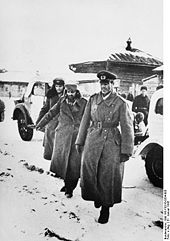 Generalfeldmarschall Friedrich Paulus (left), with his chief of staff, Generalleutnant Arthur Schmidt (right) and his aide, Wilhelm Adam (middle), after their surrender.
Generalfeldmarschall Friedrich Paulus (left), with his chief of staff, Generalleutnant Arthur Schmidt (right) and his aide, Wilhelm Adam (middle), after their surrender.
The Germans were now not only starving, but running out of ammunition. Nevertheless, they continued to resist, in part because they believed the Soviets would execute any who surrendered. In particular, the so-called "HiWis", Soviet citizens fighting for the Germans, had no illusions about their fate if captured. The Soviets were initially surprised by the number of Germans they had trapped, and had to reinforce their encircling troops. Bloody urban warfare began again in Stalingrad, but this time it was the Germans who were pushed back to the banks of the Volga. They fortified their positions in the factory districts and the Soviets encountered almost the same tooth-and-nail ferocity that they themselves had displayed a month earlier. The Germans adopted a simple defense of fixing wire nets over all windows to protect themselves from grenades. The Soviets responded by fixing fish hooks to the grenades so they stuck to the nets when thrown. The Germans now had no usable tanks in the city. Those tanks which still functioned could at best be used as makeshift pillboxes. The Soviets did not bother employing tanks in areas where the urban destruction restricted their mobility. A low-level Soviet envoy party (comprising Major Aleksandr Smyslov, Captain Nikolay Dyatlenko and a trumpeter) carried an offer to Paulus: if he surrendered within 24 hours, he would receive a guarantee of safety for all prisoners, medical care for the sick and wounded, prisoners allowed to keep their personal belongings, "normal" food rations, and repatriation to whatever country they wished to go to after the war; but Paulus—ordered not to surrender by Hitler—did not respond.[39]:283
On 30 January 1943, the 10th anniversary of his coming to power, Hitler promoted Paulus to Generalfeldmarschall. Since no German Field Marshal had ever been taken prisoner, Hitler assumed that Paulus would fight on or take his own life. However, when Soviet forces closed in on his headquarters in the ruined GUM department store the next day, Paulus surrendered. The remnants of the Axis forces in Stalingrad surrendered on 2 February; 91,000 tired, ill, wounded, and starving prisoners were taken, including 3,000 Romanians (the survivors of the 20th Infantry Division, 1st Cavalry Division and “Col. Voicu” Detachment).[40] To the delight of the Soviet forces and the dismay of the Third Reich, the prisoners included 22 generals. Hitler was furious and confided that Paulus "could have freed himself from all sorrow and ascended into eternity and national immortality, but he prefers to go to Moscow."[41]
 The interrogation of Paulus at Don Front HQ: General Rokossovsky, Marshal Voronov, translator Nikolay Dyatlenko and Paulus (left to right)
The interrogation of Paulus at Don Front HQ: General Rokossovsky, Marshal Voronov, translator Nikolay Dyatlenko and Paulus (left to right)
The German public was not officially told of the disaster until the end of January 1943, though positive media reports had stopped in the weeks before the announcement.[42] Stalingrad marked the first time that the Nazi government publicly acknowledged a failure in its war effort; it was not the first major setback of the German military, but a crushing defeat where German losses were almost equal to those of the Soviets was unprecedented. Prior losses of the Soviet Union were generally three times as high as the German ones.[42] On 31 January, regular programming on German state radio was replaced by a broadcast of the somber Adagio movement from Anton Bruckner's Seventh Symphony, followed by the announcement of the defeat at Stalingrad.[42]
On 18 February, Minister of Propaganda Joseph Goebbels gave his famous Sportpalast speech in Berlin, encouraging the Germans to accept a total war which would claim all resources and efforts from the entire population.
According to the German documentary film Stalingrad, over 11,000 soldiers refused to lay down their arms at the official surrender, presumably believing that fighting to the death was better than a slow end in Soviet camps. They continued to resist, hiding in cellars and sewers, but by early March 1943, the remaining small and isolated pockets of resistance had surrendered. According to Soviet intelligence documents shown in the documentary, a remarkable NKVD report from March 1943 is available showing the tenacity of some of these German groups: "The mopping-up of counter-revolutionary elements in the city of Stalingrad proceeded. The German-fascist bandits - who had hidden themselves in huts and trenches - offered armed resistance after combat actions had already ended. This armed resistance continued until 15 February and in a few areas until 20 February. Most of the armed groups were liquidated by March... During this period of armed conflict with the German-fascist bandits, the brigade's units killed 2.418 soldiers and officers and captured 8.646 soldiers and officers, escorting them to POW camps and handing them over". The operative report of the Don Front's staff issued on 5 February 1943, 22.00 says: "...2.The 64th Army was putting itself in order, being in previously occupied regions. Location of army's units is as it was previously. In the region of location of the 38 Motorized Rifle Brigade in a basement 18 armed SS-men (sic) were found, who refused to surrender, the Germans found were destroyed.[43] They gained time for the forces committed in the Third Battle of Kharkov that were supposed to link with them as part of a relieving force. In a report, Unteroffizier (O.A.) Karl-August Rombach from the Nachrichtenzug of II./Artillerie-Regiment 305 "stated his intention of using underground tunnels in the tractor factory to avoid captivity and await warmer weather. Many others had the same idea and thousands implemented their plans.
Of more than 91,000 German prisoners captured in Stalingrad, only about 5,000 ever returned. Already weakened by disease, starvation and lack of medical care during the encirclement, they were sent to labour camps all over the Soviet Union, where most of them died of their wounds, disease (particularly typhus), cold, overwork, mistreatment, and malnutrition. Some were kept in the city to help with rebuilding. In March 1943, 40,000 Germans were buried in a mass grave, victims of a typhus epidemic.[23]:369 A handful of senior officers were taken to Moscow and used for propaganda purposes, and some of them joined the National Committee for a Free Germany. Some, including Paulus, signed anti-Hitler statements which were broadcast to German troops. Paulus lived in the Soviet Union until 1952, then moved to Dresden in East Germany, where he spent the remainder of his days defending his actions at Stalingrad and was quoted as saying that Communism was the best hope for postwar Europe.[23]:280 General Walther von Seydlitz-Kurzbach offered to raise an anti-Hitler army from the Stalingrad survivors, but the Soviets did not accept. It was not until 1955 that the last of the 5-6,000 survivors were repatriated after a plea to the Politburo by Konrad Adenauer.
Other information
Orders of battle
- Red Army
Main article: Red Army order of battle at the Battle of StalingradDuring the defence of Stalingrad, the Red Army deployed six armies[Note 8] in and around the city and an additional nine armies in the encirclement counter offensive.[24]:435-438[Note 9]
- Axis
Main article: Axis order of battle at the Battle of StalingradCasualties
Various scholars have estimated the Axis suffered from 500,000-850,000 casualties (killed, wounded, captured) among all branches of the German armed forces and its allies, many of them POWs who died in Soviet captivity between 1943 and 1955. Of the 91,000 German POWs taken at Stalingrad, 27,000 died within weeks[44]:396 and only 5-6,000 returned to Germany by 1955. The remainder of the POWs died in Soviet captivity.[45]:196[46]:36 According to archival figures, the Red Army suffered a total of 1,129,619 total casualties;[47] 478,741 men killed or missing and 650,878 wounded. These numbers are for the whole Stalingrad area; in the city itself 750,000 were killed, captured, or wounded. The Soviet authorities executed approximately 13,500 Soviet soldiers during the battle[citation needed], equivalent to almost two rifle divisions. Also, anywhere from 955 to 40,000 Soviet civilians died in Stalingrad and its suburbs during a single week of aerial bombing as the German 4th Panzer and 6th armies approached the city; the total number of civilians killed in the regions outside the city is unknown. In all, the battle resulted in an estimated total of 1.7-2 million Axis and Soviet casualties.
Scope of the battle
At different times, the Germans had held up to 90% of the city, yet the Soviet forces fought on fiercely. At the end of the battle, the Soviet armies had encircled and besieged the 6th Army. Some elements of the German 4th Panzer Army also suffered casualties in operations around Stalingrad during the Soviet counter-offensive.
German mobility had been a significant factor in the Wehrmacht's earlier victories. Before Stalingrad, the Soviets had been able to amass their forces in sufficient numbers to achieve victory only around Moscow. Stalingrad, which had limited military value and had already been stripped of its assets, could have been bypassed and invested by the 6th Army in its drive to the Caucasus with Army Group A. Instead, Hitler chose to sacrifice many of his most experienced troops in vicious street fighting among urban rubble, which favoured the defenders and gave the Soviet Union time to amass and concentrate its forces for its pincer movement. Some Germans felt Hitler had sacrificed one of his largest and finest armies for prestige. The 6th Army was reconstituted in time for the Battle of Kursk, but was made up mostly of conscripts, and was never again the force it had once been.[23]:386
A significant factor in Germany's failure at Stalingrad was Hitler's pursuit of too many simultaneous objectives. To the South of Stalingrad, Army Group A was committed to capturing oilfields in the Caucasus and in particular at Baku in Azerbaijan. These oil fields were the original objective of the 1942 campaign, and he could have used Army Group A to bolster Army Group B's flanks around Stalingrad and perhaps to aid in fighting within the city. Clearly Hitler's ambitions were well beyond German means.[35]
Besides being a turning point in the war, Stalingrad revealed the discipline and determination of both the German Wehrmacht and the Soviet Red Army. The Soviets first defended Stalingrad against a fierce German onslaught. So great were Soviet losses that at times, the life expectancy of a newly arrived soldier was less than a day, and the life expectancy of a Soviet officer was three days. Their sacrifice is immortalized by one of General Rodimtsev's soldiers, about to die, who scratched on the wall of the main railway station—which changed hands 15 times during the battle—“Rodimtsev’s Guardsmen fought and died here for their Motherland.”
A significant historical debate concerns the degree of terror in the Red Army. The British historian Anthony Beevor noted the claim from the Stalingrad Front’s Political Department on 8 October 1942 that: “The defeatist mood is almost eliminated and the number of treasonous incidents is getting lower” as an example of the sort of coercion that the Special Detachments (later to be renamed SMERSH) subjected the Red Army soldiers to.[48]:154-168 On the other hand, Beevor noted the often extraordinary bravery of the Soviet soldiers in a battle that was only comparable to Verdun, and argued that such self-sacrifice cannot be explained by terror alone.[24]:154-168
For the heroism of the Soviet defenders of Stalingrad, the city was awarded the title Hero City in 1945. Twenty-four years after the battle, in October 1967,[49] a colossal monument, Mother Motherland, was erected on Mamayev Kurgan, the hill overlooking the city. The statue forms part of a War memorial complex which includes ruined walls deliberately left the way they were after the battle. The Grain Silo, as well as Pavlov's House, the apartment building whose defenders eventually held out for two months until they were relieved, can still be visited. Even today one may find bones and rusty metal splinters on Mamayev Kurgan, symbols of both the human suffering during the battle and the successful yet costly resistance.
Many women fought on the Soviet side, or were under fire. At the beginning of the battle there were 75,000 women and girls from the Stalingrad area who had finished military or medical training, and all of whom were to serve in the battle. Women staffed many of the anti-aircraft batteries that fought not only the Luftwaffe but also German tanks.[50]:180-192 Soviet nurses not only treated wounded men under fire but were involved in the highly dangerous work of bringing wounded soldiers back to the hospitals under enemy fire.[50] Many of the Soviet wireless and telephone operators were women who often suffered heavy casualties when their command posts came under fire.[50]:193-197 Though women were not usually trained as infantry, many Soviet women fought as machine gunners, mortar operators, snipers and scouts.[50] With three entirely female air regiments, women were fulfilling the role of pilots, as well.[50] At least three women won the title Hero of the Soviet Union while driving tanks at Stalingrad.[51]:204-207
The German Army showed remarkable discipline after being surrounded. It was the first time that it had operated under adverse conditions on such a scale. During the latter part of the siege, short of food and clothing, many German soldiers starved or froze to death. Yet, discipline was maintained until the very end, when resistance no longer served any useful purpose. Friedrich Paulus obeyed Hitler's orders, against many of Hitler's top generals' counsel and advice, including that of von Manstein, and did not attempt to break out of the city. German ammunition, supplies, and food became all too scarce.
Paulus knew that the airlift had failed and that Stalingrad was lost. He asked for permission to surrender to save the lives of his troops, but Hitler refused and instead promoted him to the rank of Generalfeldmarschall. No German officer of this rank had ever surrendered, and the implication was clear: if Paulus surrendered, he would shame himself and would become the highest ranking German officer ever to be captured. Hitler believed that Paulus would either fight to the last man or commit suicide. Paulus surrendered, commenting, "I have no intention of shooting myself for this Bohemian corporal". (Beevor, p. 381.)[Note 10]
In popular culture
Main article: Battle of Stalingrad in popular cultureThe extreme conditions of the battle, including the paralyzing Soviet winter that precipitated massive German fatalities due to starvation and freezing, have been immortalized in several films of German, Russian,[52] British and American origin. The struggle is also remembered and reflected upon in numerous books, for its significance in thwarting the German invasion, as well as its significance as a landmark of military barbarism and human suffering in which the loss of life was unprecedented.
See also
- Barmaley Fountain
- Hungary during World War II
- Independent State of Croatia
- Italian participation in the Eastern Front
- List of officers and commanders in the Battle of Stalingrad
- Romanian Armies in the Battle of Stalingrad
- Sword of Stalingrad
Notes, citations and bibliography
Footnotes
- ^ The Soviet fronts composition and names changed several times in the battle. The battle started with the South Western Front. It was later renamed Stalingrad Front, then had the Don Front split off from it.
- ^ The Front was reformed from reserve armies on October 22, 1942.
- ^ This force grew to 1,600 in early September by withdrawing forces from the Kuban region and Southern Caucasus: Hayward (1998), p. 195.
- ^ Order No. 227 of July 28, 1942.
- ^ Bergström quotes: Soviet Reports on the effects of air raids between 23–26 August 1942. This indicates 955 people were killed and another 1,181 wounded
- ^ 8,314 German aircraft were produced from July–December 1942, but this could not keep pace with a three-front aerial war of attrition
- ^ Shirer p. 926 says that "Paulus radioed that they would need a minimum of 750 tons of supplies day flown in," while Craig pp. 206–207 quotes Zeitzler as pressing Goering about his boast that the Luftwaffe could airlift the needed supplies: "Are you aware ... how many daily sorties the army in Stalingrad will need? ... Seven hundred tons! Every day!"
- ^ 8th, 28th, 51st, 57th, 62nd and 64th Armies
- ^ 24th, 65th, 66th and 16th Air Army from the north as part of the Don Front offensive and 1st Guards, 5th Tank, 21st, 2nd Air and 17th Air Army from the south as part of the South Western Front
- ^ Für so einen Schweinehund wie den böhmischen Gefreiten erschieße ich mich nicht! (engl: I am not going to shoot myself for such a swine as this Bohemian corporal!), quoted in: "Ich bitte erschossen zu werden", Der Spiegel, 01-29-1949
Citations
- ^ a b c d e f g h i j k l m n o Bergström (2007)
- ^ a b Krivosheev (1965), pp. 181–2
- ^ a b Rokossovsky (1965), pp. 254–8
- ^ a b c d e f Hayward, (1998)
- ^ Bergstrom (2005)
- ^ Glantz (1995), p. 134
- ^ Glantz (1995), p. 295
- ^ McDougal Littell, (2006)
- ^ Roberts (2006: 143)
- ^ Biesinger (2006: 699): "On August 23, 1942, the Germans began their attack."
- ^ "Battle of Stalingrad". Encyclopædia Britannica. "By the end of August, … Gen. Friedrich Paulus, with 330,000 of the German Army's finest troops… approached Stalingrad. On August 23 a German spearhead penetrated the city's northern suburbs, and the Luftwaffe rained incendiary bombs that destroyed most of the city's wooden housing."
- ^ Taylor (1998) Vol IV, p. 142
- ^ a b c Bellamy, (2007)
- ^ a b c d e f Shirer (1990)
- ^ a b Kershaw, (2000)
- ^ Taylor and Clark, (1974)
- ^ McDonald (1986)
- ^ Kershaw (2000)
- ^ German High Command (communique) (27 October 1941). "Text of the Day's War Communiques". New York Times (28 October 1941). http://collections.civilisations.ca/warclip/objects/common/webmedia.php?irn=5000808. Retrieved 27 April 2009.
- ^ German High Command (communique) (10 November 1942). "Text of the Day's War Communiques on Fighting in Various Zones". New York Times (10 November 1942). http://collections.civilisations.ca/warclip/objects/common/webmedia.php?irn=5001262. Retrieved 27 April 2009.
- ^ German High Command (communique) (26 August 1942). "Text of the Day's War Communiques on Fighting in Various Zones". New York Times (26 August 1942). http://collections.civilisations.ca/warclip/objects/common/webmedia.php?irn=5001240. Retrieved 27 April 2009.
- ^ German High Command (communique) (12 December 1942). "Text of the Day's War Communiques". New York Times (12 December 1942). http://collections.civilisations.ca/warclip/objects/common/webmedia.php?irn=5001290. Retrieved 27 April 2009.
- ^ a b c d e f g Craig, (1973)
- ^ a b c d e f g h i j Beevor (1998)
- ^ a b Pojić, Milan. Hrvatska pukovnija 369. na Istočnom bojištu 1941. – 1943.. Croatian State Archives. Zagreb, 2007.
- ^ Hayward (1998)
- ^ "Stalingrad 1942". http://stalingrad-info.com/stalingrad1942.htm. Retrieved 31 January 2010.
- ^ a b c TV Novosti. "Crucial WW2 battle remembered". http://www.russiatoday.com/Top_News/2009-02-02/Crucial_WW2_battle_remembered.html. Retrieved 19 February 2009.
- ^ Golovanov, (2004)
- ^ Goodwin (1994)
- ^ Glantz (1989), Soviet Military Deception in the Second World War, pp. 108–119
- ^ Haupt (1998)
- ^ Maps of the conflict. Leavenworth Papers No. 2 Nomonhan: Japanese-Soviet Tactical Combat, 1939; MAPS. Retrieved 5 December 2009.
- ^ Manstein (2004)
- ^ a b Walsh, Stephen. (2000). Stalingrad 1942–1943 The Infernal Cauldron. London, New York: Simon & Schuster. ISBN 0-7432-0916-8.
- ^ Paoletti, Ciro (2008). A Military History of Italy. Westport, CT: Praeger Security International. p. 177. ISBN 0275985059. http://books.google.com/?id=Uz8eiwzEMHQC&pg=PA182&dq=Ariete+tanks+fight!#PPA177,M1. Retrieved 4 December 2009.
- ^ Deiml, Michael (1999). Meine Stalingradeinsätze (My Stalingrad Sorties). Einsätze des Bordmechanikers Gefr. Michael Deiml (Sorties of Aviation Mechanic Private Michael Deiml). Retrieved 4 December 2009.
- ^ MacDonald, (1986)
- ^ Clark (1995)
- ^ Pusca, Dragos; Nitu, Victor. The Battle of Stalingrad — 1942 Romanian Armed Forces in the Second World War (worldwar2.ro). Retrieved 4 December 2009.
- ^ Victor, George (2000). Hitler: Pathology of Evil. Washington, DC: Brassey's Inc. p. 208. ISBN 1574882287. http://books.google.com/?id=JnB7cM1zUG4C&printsec=frontcover&dq=george+victor. Retrieved 23 August 2008.
- ^ a b c Sandlin, Lee (1997). "Losing the War". Originally published in Chicago Reader, 7 and 14 March 1997. Retrieved 4 December 2009.
- ^ Google Video: (in Finnish; interviews in German & Russian, with Finnish subtitles) (Adobe Flash) Stalingrad — OSA III — Stalingradin taistelu päättyy (Stalingrad, Part 3: Battle of Stalingrad ends) (Television documentary. German original: "Stalingrad" Episode 3: "Der Untergang", 53 min, Sebastian Dehnhardt, Manfred Oldenburg (directors) IMDB). broadview.tv GmbH, Germany 2003. http://video.google.com/videoplay?docid=8717261858113724758. Retrieved 16 July 2007.
- ^ Rayfield (2004)
- ^ Baird, (1969)
- ^ Bernig, Jorg, (1997)
- ^ Сталинградская битва (Russian). Retrieved 4 December 2009.
- ^ Beevor (2004)
- ^ Historical Memorial Complex "To the Heroes of the Stalingrad Battle" at Mamayev Hill. Official web site. Retrieved 17 July 2008.
- ^ a b c d e Pennington (2004)
- ^ Pennington, (2004)
- ^ "The Great Battle on the Volga (1962)". Video.google.com. http://video.google.com/videoplay?docid=4562967572164209056&q=duration%3Along+is%3Afree+genre%3AMOVIE_FEATURE. Retrieved 2010-11-12.
Bibliography
- Baird, Jay W (1969). The Myth of Stalingrad, Journal of Contemporary History, Sage Publications, Ltd.
- Beevor, Antony (1998). Stalingrad. Viking, London. ISBN 1315171920181614.
- Beevor, Anthony “Stalingrad and Researching the Experience of War” pages 154-168 from Russia War, Peace and Diplomacy Essays in Honour of John Erickson edited by Ljubica and Mark Erickson, London: Weidenfeld & Nicolson, 2004, ISBN 0297849131.
- Bellamy, Chris (2007). Absolute War: Soviet Russia in the Second World War. New York: Alfred A. Knopf & Random House. ISBN 9780375410864.
- Bernig,Jorg (1997). Eingekesselt: Die Schlacht um Stalingrad im deutschsprachigen Roman nach 1945: (German Life and Civilization Journal No 23), : Peter Lang publishers.
- Bergström, Christer. Dikov, Andrey and Antipov Vladimir (2006). Black Cross Red Star: Air War Over the Eastern Front: Everything For Stalingrad, Volume 3. Eagle Editions. ISBN 978-0-9761034-4-8.
- Clark, Alan (1965). Barbarossa: the Russian-German conflict OCLC 154155228
- Craig, William (1973). Enemy at the Gates: The Battle for Stalingrad New York: Penguin Books (paperback, ISBN 0-14-200000-0)
- Einsiedel, Heinrich Graf von; Wieder, Joachim. Stalingrad: Memories and Reassessments. New York: Sterling Publishing, 1998 (paperback, ISBN 1-85409-460-2); London: Cassell, 2003 (paperback, ISBN 0-304-36338-3).
- Erickson, John. The Road to Stalingrad: Stalin's War with Germany, Vol. 1. Boulder, CO: Westview Press, 1984 (hardcover, ISBN 0-86531-744-5); New York: HarperCollins Publishers, 1985 (hardcover, ISBN 0-586-06408-7); New Haven, CT; London: Yale University Press, 1999 (paperback, ISBN 0-300-07812-9); London: Cassell, 2003 (paperback, ISBN 0-304-36541-6).
- Glantz, David M. & House, Jonathan (1995), When Titans Clashed: How the Red Army Stopped Hitler, Lawrence, Kansas: University Press of Kansas, ISBN 0700608990
- Glantz, David M. & House, Jonathan (2009), 'To the Gates of Stalingrad - Soviet-German combat operations April to August 1942', Kansas, Kansas University Press, ISBN 978-0-7006-1630-5
- Glantz, David M. & House, Jonathan (2009), 'Armageddon in Stalingrad - September to November 1942', Kansas, Kansas University Press, ISBN 978-0-7006-1664-0
- Glantz, David (2011), 'After Stalingrad: The Red Army's Winter Offensive 1942-1943', Helion and Company, ISBN 978-1907677052
- Golovanov, A.Ye.(2004) Dalnyaya bombardirovochnaya. Delta NB, Moscow.
- Goodwin, Doris Kearns (1994). No Ordinary Time: Franklin and Eleanor Roosevelt: The Home Front in World War II. New York: Simon & Schuster (paperback, ISBN 0-671-64240-5)
- Hayward, Joel S. A. (1998). Stopped at Stalingrad: The Luftwaffe and Hitler's Defeat in the East 1942-1943. Lawrence, KS, University Press of Kansas. ISBN 978-0-700608768.
- Kershaw, Ian (2000). Hitler: 1936-1945: Nemesis. London: Penguin Books. ISBN 978-0-14-027239-0.
- MacDonald, John. (1986) Great Battles of World War II. London: Michael Joseph books.
- Modern world history : patterns of interaction. Evanston, IL: McDougal Littell. 2006. ISBN 0618557156.
- Manstein, Erich von; Powell, Anthony G. (Ed. & Trans.); Liddell Hart, B. H. (Preface); Blumenson, Martin (Introduction) (2004). Lost Victories: The War Memoirs of Hitler's Most Brilliant General. St. Paul, MN: Zenith Press. ISBN 0-7603-2054-3.
- Pennington, Reina “Women and the Battle of Stalingrad” pages 169-211 from Russia War, Peace and Diplomacy Essays in Honour of John Erickson edited by Ljubica and Mark Erickson, London: Weidenfeld & Nicolson, 2004, ISBN 0297849131.
- Rayfield, Donald. Stalin and His Hangmen: The Tyrant and Those Who Killed for Him. New York: Random House, 2004 (hardcover, ISBN 0-375-50632-2); 2005 (paperback, ISBN 0-375-75771-6).
- Shirer, William L. (1960 reprinted 1990). The Rise and Fall of the Third Reich: A History of Nazi Germany New York: Simon & Schuster.
- Taylor, A.J.P. and Mayer, S.L., eds. (1974) A History Of World War Two. London: Octopus Books. ISBN 0-7064-0399-1.
- Taylor, A.J.P. (1998). The Second World War and its Aftermath. Folio Society (Vol 4 of 4).
Additional sources
- Antill, Peter (2007). Stalingrad 1942, Osprey Publishing, London. ISBN 1846030285
- Biesinger, Joseph A. (2006). Germany: a reference guide from the Renaissance to the present. Infobase Publishing, New York City. ISBN 9780816045211
- Corum, James S. (2008). Wolfram von Richthofen: Master of the German Air War. Lawrence, KS, University Press of Kansas. ISBN 978-0-7006-1598-8.
- Dibold, Hans (2001) Doctor at Stalingrad. Littleton, CO: Aberdeen, (hardcover, ISBN 0-9713852-1-1).
- Grossman, Vasiliĭ Semenovich; Beevor, Antony; Vinogradova, Luba (2007). A Writer at War:A Soviet Journalist with the Red Army, 1941 - 1945. New York: Vintage Books. ISBN 978-0-307-27533-2.
- Holl, Adelbert. (2005) An Infantryman In Stalingrad: From 24 September 1942 to 2 February 1943. Pymble, NSW, Australia: Leaping Horseman Books (hardcover, ISBN 0-9751076-1-5).
- Hoyt, Edwin Palmer. (1999) 199 Days: The Battle for Stalingrad. New York: A Forge Book, (paperback, ISBN 0-312-86853-7).
- Jones, Michael K. (2007) Stalingrad: How the Red Army Survived the German Onslaught. Drexel Hill, PA: Casemate, (hardcover, ISBN 978-1-932033-72-4)
- Mayer, SL & Taylor, AJP (1974). History of World War II. London: Octopus Books. ISBN 0-7064-0399-1 & ISBN 978-0-7064-0399-2
- Raus, Erhard. Panzer Operations: The Eastern Front Memoir of General Raus, 1941–1945, compiled and translated by Steven H. Newton. Cambridge, MA: Da Capo Press, 2003 (hardcover, ISBN 0-306-81247-9); 2005 (paperback, ISBN 0-306-81409-9).
- Roberts, Geoffrey. (2002) Victory at Stalingrad: The Battle that Changed History. New York: Longman, (paperback, ISBN 0-582-77185-4).
- —— (2006) Stalin's wars: from World War to Cold War, 1939-1953. Yale University Press, ISBN 0300112041
- Samsonov A.M., (1989) Stalingrad Battle, 4th ed. re-edited and added-to, Moscow, Science publishing. Russian: Самсонов А.М. Сталинградская битва, 4-е изд., испр. и доп.— М.: Наука, 1989. (in Russian)
- Snyder, David R. (2005). Review in The Journal of Military History Volume 69 (1).
- Zhukov, Georgiĭ Konstantinovich & Harrison E., Salisbury (1969). Marshal Zhukov's Greatest Battles. New York: Harper & Row. OCLC 563797912.
External links
- Stalingrad Original reports from The Times
- Detailed summary of campaign
- Stalingrad-info.com, Russian archival docs translated into English,original battle maps,aerial photos,pictures taken at the battlefields,relics collection
- Story of the Stalingrad battle with pictures, maps, video and other primary and secondary sources
- Volgograd State Panoramic Museum official homepage
- Battle Of Stalingrad – The Tide of the Second World War Turns Decisively in Favour of the Allies
- The Battle of Stalingrad in Film and History Written with strong Socialist/Communist political under and overtones.
- Roberts, Geoffrey. "Victory on the Volga", The Guardian, 28 February 2003
- The Great Battle on the Volga on Google Video
- Stalingrad – Bilder einer erbitterten Schlacht (German)
- Battle of Stalingrad Pictures from World War II-Pictures.com
- H-Museum: Stalingrad/Volgograd 1943 - 2003. Memory
- Battle of Stalingrad Pictures
- Stalingrad Order of Battle : Units, Commanders and Men in STALDATA : comprehensive information about Stalingrad battle
- View footage from the Battle of Stalingrad in January 1943
Battle of StalingradAirfields · Axis order of battle · Red Army order of battle · Bombing of Stalingrad in World War II · German commanders · German units Operations Formations  4th Panzer · 6th
4th Panzer · 6th
 2nd
2nd
 8th
8th
 3rd · 4th
3rd · 4th
 1st Guards · 2nd Guards · 3rd Guards · 21st · 51st · 62nd · 64th · 65th
1st Guards · 2nd Guards · 3rd Guards · 21st · 51st · 62nd · 64th · 65th XIV Panzer · XL Panzer · XLVIII Panzer · IV · VIII · XI · LI · 8th Air
XIV Panzer · XL Panzer · XLVIII Panzer · IV · VIII · XI · LI · 8th Air
 1st Tank · 4th Tank · 13th Tank · 16th Tank · 24th Tank · 26th Tank · 4th Mechanised · 13th Mechanised · 3rd Guards Cavalry · 4th Cavalry · 8th Cavalry
1st Tank · 4th Tank · 13th Tank · 16th Tank · 24th Tank · 26th Tank · 4th Mechanised · 13th Mechanised · 3rd Guards Cavalry · 4th Cavalry · 8th Cavalry 6th Panzer · 14th Panzer · 16th Panzer · 17th Panzer · 22nd Panzer, · 24th Panzer · 3rd Motorised Infantry · 29th Motorised Infantry · 60th Motorised Infantry · 5th Infantry · 44th Infantry · 71st Infantry · 76th Infantry · 79th Infantry · 94th Infantry · 100th Infantry · 113th Infantry · 295th Infantry · 297th Infantry · 305th Infantry · 371st Infantry · 376th Infantry · 384th Infantry · 389th Infantry
6th Panzer · 14th Panzer · 16th Panzer · 17th Panzer · 22nd Panzer, · 24th Panzer · 3rd Motorised Infantry · 29th Motorised Infantry · 60th Motorised Infantry · 5th Infantry · 44th Infantry · 71st Infantry · 76th Infantry · 79th Infantry · 94th Infantry · 100th Infantry · 113th Infantry · 295th Infantry · 297th Infantry · 305th Infantry · 371st Infantry · 376th Infantry · 384th Infantry · 389th Infantry
 13th Guards Rifle · 15th Guards Rifle · 33rd Guards Rifle · 35th Guards Rifle · 36th Guards Rifle · 37th Guards Rifle · 39th Guards Rifle · 38th Rifle · 45th Rifle · 62nd Rifle · 64th Rifle · 91st Rifle · 93rd Rifle · 95th Rifle · 112th Rifle · 138th Rifle · 157th Rifle · 169th Rifle · 173rd Rifle · 181st Rifle · 193rd Rifle · 196th Rifle · 204th Rifle · 214th Rifle · 221st Rifle · 248th Rifle · 284th Rifle · 302nd Rifle · 308th Rifle · 422nd Rifle · 685th Rifle · 414th Anti-Tank · 149th Artillery · 60th Cavalry · 81st Cavalry
13th Guards Rifle · 15th Guards Rifle · 33rd Guards Rifle · 35th Guards Rifle · 36th Guards Rifle · 37th Guards Rifle · 39th Guards Rifle · 38th Rifle · 45th Rifle · 62nd Rifle · 64th Rifle · 91st Rifle · 93rd Rifle · 95th Rifle · 112th Rifle · 138th Rifle · 157th Rifle · 169th Rifle · 173rd Rifle · 181st Rifle · 193rd Rifle · 196th Rifle · 204th Rifle · 214th Rifle · 221st Rifle · 248th Rifle · 284th Rifle · 302nd Rifle · 308th Rifle · 422nd Rifle · 685th Rifle · 414th Anti-Tank · 149th Artillery · 60th Cavalry · 81st CavalryNotable
participants Adolf Hitler · Alexander Edler von Daniels · Wilhelm Hoffman · Hermann Hoth · Hans-Valentin Hube · Erwin König · Erich von Manstein · Friedrich Paulus · Wolfram von Richthofen · Arthur Schmidt · Walther von Seydlitz-Kurzbach · Karl Strecker
Adolf Hitler · Alexander Edler von Daniels · Wilhelm Hoffman · Hermann Hoth · Hans-Valentin Hube · Erwin König · Erich von Manstein · Friedrich Paulus · Wolfram von Richthofen · Arthur Schmidt · Walther von Seydlitz-Kurzbach · Karl Strecker
 Viktor Pavičić
Viktor Pavičić
 Italo Gariboldi
Italo Gariboldi
 Gusztáv Vitéz Jány
Gusztáv Vitéz Jány
 Constantin Constantinescu-Claps · Petre Dumitrescu · Mihail Lascăr
Constantin Constantinescu-Claps · Petre Dumitrescu · Mihail Lascăr
 Joseph Stalin · Azi Aslanov · Vasily Badanov · Vasily Chuikov · Nikolay Dyatlenko · Sasha Fillipov · Peter Gitelman · Vasily Grossman · Nikita Khrushchev · Dmitry Lelyushenko · Rodion Malinovsky · Yakov Pavlov · Alexander Rodimtsev · Konstantin Rokossovsky · Alexander Shcherbakov · Semyon Timoshenko · Aleksandr Vasilevsky · Nikolay Voronov · Erich Weinert · Andrei Yeremenko · Vasily Zaytsev · Georgy Zhukov
Joseph Stalin · Azi Aslanov · Vasily Badanov · Vasily Chuikov · Nikolay Dyatlenko · Sasha Fillipov · Peter Gitelman · Vasily Grossman · Nikita Khrushchev · Dmitry Lelyushenko · Rodion Malinovsky · Yakov Pavlov · Alexander Rodimtsev · Konstantin Rokossovsky · Alexander Shcherbakov · Semyon Timoshenko · Aleksandr Vasilevsky · Nikolay Voronov · Erich Weinert · Andrei Yeremenko · Vasily Zaytsev · Georgy ZhukovLocations Barmaley Fountain · Barrikady works · Grain silo · Gumrak · Kalach · Mamayev Kurgan · Pavlov's House · Pitomnik Airfield · Red October Steel Factory · River Don · River Volga · Tatsinskaya Airfield · Tsaritsa gorge · Volgograd Tractor FactoryIn memoriam The Motherland Calls · Stalingrad Madonna · Sword of Stalingrad · Battle of Stalingrad in popular cultureSee also: Battle of the Caucasus · Battle of Kursk · Battle of Nikolayevka · Case Blue · Operation Barbarossa · Second Battle of Kharkov · Third Battle of Kharkov · Volgograd World War II Participants Timeline - Burma
- Changsha (1942)
- Coral Sea
- Gazala
- Midway
- Blue
- Stalingrad
- Dieppe
- El Alamein
- Torch
- Guadalcanal
Aspects GeneralWar crimes- German and Wehrmacht war crimes
- The Holocaust
- Italian war crimes
- Japanese war crimes
- Allied war crimes
- Soviet war crimes
- United States war crimes
- German military brothels
- Camp brothels
- Rape during the occupation of Japan
- Comfort women
- Rape of Nanking
- Rape during the occupation of Germany
- Nazi crimes against Soviet POWs
- Italian prisoners of war in the Soviet Union
- Japanese prisoners of war in the Soviet Union
- Japanese prisoners of war in World War II
- German prisoners of war in the Soviet Union
- Finnish prisoners of war in the Soviet Union
- Polish prisoners of war in the Soviet Union
- Romanian prisoners of war in the Soviet Union
- German prisoners of war in the United States
Categories:- 1942 in the Soviet Union
- 1943 in the Soviet Union
- Adolf Hitler
- Battle of Stalingrad
- Battles and operations of the Soviet–German War
- Battles involving the Soviet Union
- Battles of World War II involving Romania
- Battles of World War II involving Italy
- Battles of World War II involving Hungary
- History of Slovakia
- Joseph Stalin
- Sniper warfare
- Strategic operations of the Red Army in World War II
- Urban warfare
- World War II aerial operations and battles of the Eastern Front
- Airbridge
Wikimedia Foundation. 2010.

